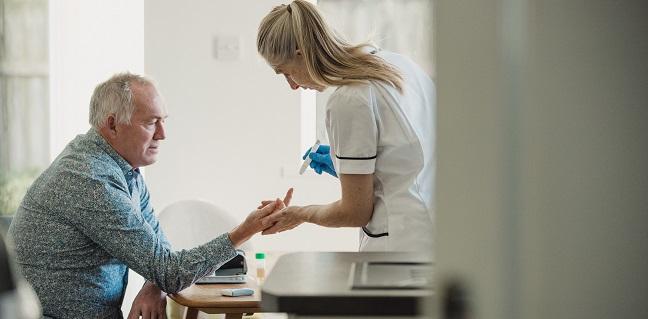Nearly Half of Diabetic Patients Struggle to Pay Medical Bills
These people are much more likely to be financially distressed, not have enough to eat, and skimp or forgo medical care.

Roughly two out of every five adults with diabetes say they are having financial difficulties related to their overall medical care, with these patients either reporting a financial hardship because of their medical bills or being forced to pay off bills over time by taking on loans or credit card debt, a new study shows.
One out of every six adults with diabetes, or an estimated 2 million people in the United States, is unable to pay their medical bills at all. Most of these diabetic patients have an average-to-poor cardiovascular risk factor profile and the majority of those who reported difficulties paying their medical bills have at least 1 or other comorbidity, including, but not limited to, atherosclerotic cardiovascular disease.
“The numbers are staggering,” said senior investigator Khurram Nasir, MD, MPH (Houston Methodist DeBakey Heart & Vascular Center, TX), noting that the two most vulnerable groups were patients from low-income families and those without insurance. Among diabetic patients in the low-income bracket without insurance, 40% are unable to pay their medical bills at all. “It’s a huge, huge burden, especially when we consider what it entails,” he emphasized.
To TCTMD, Nasir said patients with diabetes face a great deal of financial challenges, especially with rising insulin costs. Patients with diabetes incur large out-of-pocket costs for treatment, with one study reporting costs of more $1,800 per year and a total lifetime expenditure exceeding $100,000. Another study showed that approximately one-quarter of patients with diabetes are part of a family that spends at least 10% of their income on healthcare-related expenses.
The new study, published February 6, 2020, in Circulation: Cardiovascular Quality and Outcomes with César Caraballo, MD (Yale New Haven Health, CT), and Javier Valero-Elizondo, MD, MPH (Houston Methodist DeBakey Heart & Vascular Center), as lead authors, included 164,696 individuals 64 years and younger who were questioned between 2013-2017 as part of the National Health Interview Survey. Of these, 8,967 reported a diagnosis of diabetes mellitus (mean age 51.6 years; 49.1% women).
[Diabetes] affects millions of individuals, and now at least two to five million adults are adversely affected by their medical bills. Khurram Nasir
Among those with diabetes, 41.1% reported being part of a family that had problems paying medical bills in the past 12 months or were currently paying medical bills off over time. Based on the sample, this translates to 5.4 million US adults experiencing such financial hardships. Another 15.6% reported they were unable to pay medical bills at all. The financial burden from medical bills hit low-income families, those without insurance, non-Hispanic black patients, and those with more comorbidities the hardest.
Patients with a poor cardiovascular risk profile, defined as having four or more risk factors, were more likely than those with an optimal cardiovascular risk profile to report financial hardship related to their bills (OR 1.43; 95% CI 1.15-1.77), as were those with additional comorbidities. Diabetics with a poor cardiovascular risk profile were also more likely than those with an optimal profile to report not being able to pay their medical bills at all (OR 1.74; 95% CI 1.25-2.42).
Compared with diabetic patients without any financial hardships related to medical care, individuals with financial difficulty had a higher overall degree of financial distress (52.1% vs 25.4%), greater food insecurity (30.0% vs 12.8%), and a higher rate of cost-related medication nonadherence (34.7% vs 9.1%). Additionally, those with financial difficulties were more likely to avoid or delay medical care (55.0% vs 21.6% for those without financial trouble).
“We’re not talking about a condition that affects a few hundred patients,” said Nasir. “We’re talking about diabetes, which is unfortunately one of the most widespread chronic diseases in the country. It affects millions of individuals, and now at least two to five million adults are adversely affected by their medical bills.”
In a comparison with adults without diabetes, those with diabetes had a greater prevalence of financial hardship with respect to their medical bills (41.1% vs 28.6%; P < 0.001) and were much more likely to suffer consequences from it, such as having greater overall financial distress, food insecurity, not adhering to medical therapy because of costs, and foregoing medical care altogether. In a comparison of elderly patients with diabetes—those 65 years and older covered by Medicare—younger diabetic patients were twice as likely to report financial hardship and suffer its consequences.
“There are many challenges that may come with Medicare for all, or with an expansion, but at least in the current stage, people covered by Medicare tend to have less financial toxicity [than those not covered],” said Nasir.
While it’s unknown if an expansion of Medicare would address the financial burden of patients with diabetes, Nasir said these new data will allow policymakers to see the scope of the problem. In clinic, physicians can also help by asking about the economic status of patients when treating them.
“If we’re able to screen them, then we can be mindful of tests and management that might not provide the most value and to understand how much it’s going to cost them,” he said. “Also, we can help by directing them to community resources. For example, there are samples, generic medications, free clinics—lots of things can happen if we take charge in screening these individuals.”
Michael O’Riordan is the Managing Editor for TCTMD. He completed his undergraduate degrees at Queen’s University in Kingston, ON, and…
Read Full BioSources
Caraballo C, Valero-Elizondo J, Khera R, et al. Burden and consequences of financial hardship from medical bills among nonelderly adults with diabetes mellitus in the United States. Circ Cardiovasc Qual and Outcomes. 2020;Epub ahead of print.
Disclosures
- Nasir, Caraballo, and Valero-Elizondo report no relevant conflicts of interest.


Comments